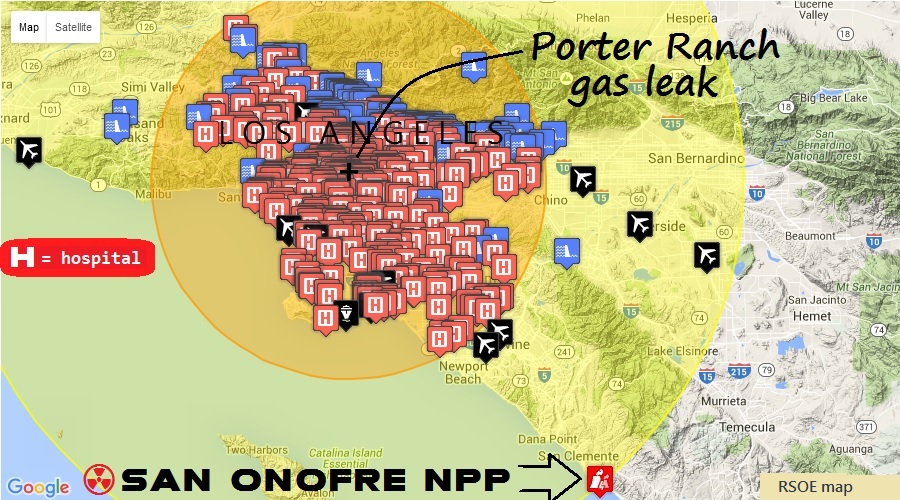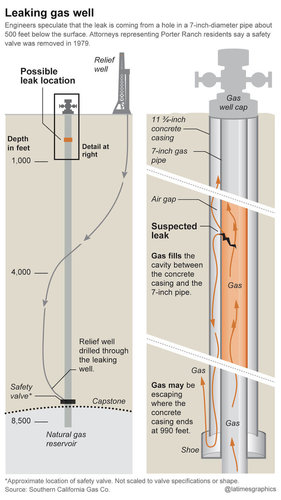State of Emergency: Radioactive material, byproduct of Uranium, released from massive gas blowout in LA
ENE News
Expert: “A lot” has been detected, very dangerous
Official: “Levels can cause “significant health risks.”
Approximate location of safety valve. (not scaled to specs or shape) Source: Southern California Gas Co.
Robert Kennedy Jr., Jan 8, 2016: Their animals are dying… their fish are dying in their fish bowls, their dogs are dying, their cats are getting sick. And their children are getting sick — they’re suffering nose bleeds, they’re suffering terrible debilitating migraine headaches, asthma attacks, respiratory infections, eye infections, ear infections, stomach ailments…
The health impact — it’s not just methane coming out of that hole… This is global crisis, more importantly this is a local crisis. Because not only do you have methane — you have benzene, toluene, xylene, which are carcinogenic. You have hydrogen sulfide, sulfur dioxide — which are neurotoxic, which can injure your brain, affect memory, injure your kidneys, your liver, your other bodily organs. There’s also a lot of radon gas being measured in the area. People believe — we don’t know if this is true — the gas that is leaking at 2 miles deep is now coming out and pushing that radon up into people’s living rooms, their bedrooms, their nurseries.
Lawyers and Settlements, Jan 7, 2016: The leak has caused a continuous flow of gases and fluids. Methane alone is leaking 100,000 pounds per hour, according to Los Angeles city attorney Mike Feuer. Along with that greenhouse gas is methyl mercaptans (odorants added to gas to aid in leak detection) and aromatic hydrocarbons. More concernedly, health officials have identified benzene and radon, both known carcinogens.
CBS LA, Dec 11, 2015: Dr. Cyrus Rangan, the Director of Toxicology and Assessment for the county, came to CBS2/KCAL9 to answer questions…. It’s been reported that radon is being released… “This is a theoretical possibility,” Dr. Rangan said, “and when you’re addressing a problem that might be several hundred or even several thousand feet deep, you might generate what are called preferential pathways for something like radon, beneath the Earth’s surface, to make its way up to the surface. So primarily our concern about radon is from the worker’s exposure, for the people actually doing the repair job. If we find radon there, we can address the situation. And if radon does exist in the work site then we may need to have to look at the residential community and monitor for it.”
Robert Kennedy Jr., Dec 17, 2015: Public officials and the gas industry have a tricky and deceptive way of saying things. Methane itself is not dangerous… methane is an indicator that other gases are involved, including radon and benzene, both carcinogenic and very dangerous… gas can escape through any perforation in the earth and on the way up to the surface, it can encounter the aquifers underground, where it will leave behind chemicals, including benzene and radon.
Erin Brokovich, Dec 22, 2015: [B]enzene and radon [are] the carcinogens that are commonly found in natural gas.
Lawyers and Settlements, Dec 12, 2015: There is the issue of radon, a naturally occurring byproduct of uranium… as SoCalGas and its partners bore into the ground in an attempt to stem a leak that is unleashing a constant cloud of gas into the atmosphere, radon has crept into the conversation.
Los Angeles Daily News, Dec 2, 2015: [R]adon gas, which may potentially be released during repair operations, is also a concern [L.A. County Department of Public Health Interim Director Cynthia Harding] said.
Los Angeles Times, Dec 2, 2015: Los Angeles County Supervisor Michael D. Antonovich said a new report by county public health officials had concluded that since the gas leak has continued for so long, emissions levels could produce “significant long-term health effects, including cancer.” Antonovich said the report had identified benzene as the “chemical of greatest concern,” because it is known to cause cancer. It also cited concerns about radon, another known carcinogen.
KPCC, Dec 9, 2015: Public Health Director Cynthia Harding told members of the Board of Supervisors in a Dec. 1 letter [that radon] could also be released as the leak is repaired.
Los Angeles Times, Dec 20, 2015: Health officials are also concerned that the company’s attempt to fix the leak by drilling into the ground to construct a relief well could release radon, a radioactive, naturally occurring and odorless gas that is found in geologic formations and causes lung cancer.
___
http://www.sott.net/article/310140-State-of-Emergency-Radioactive-material-byproduct-of-Uranium-released-from-massive-gas-blowout-in-LA?utm_content=buffer09c4b&utm_medium=social&utm_source=facebook.com&utm_campaign=buffer

